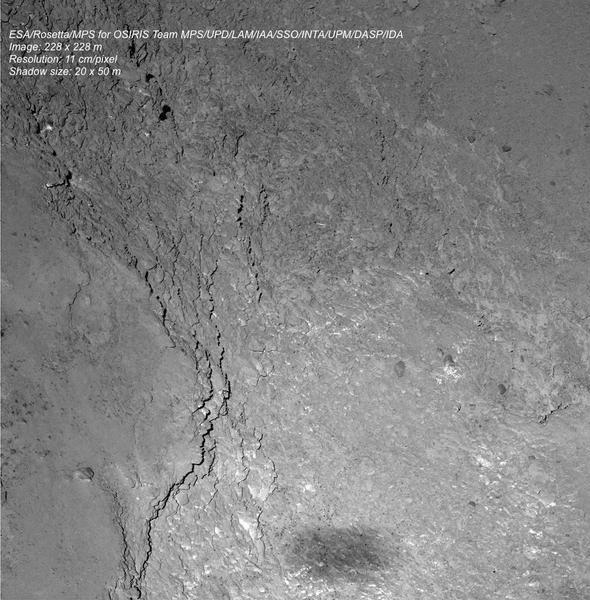I suppose, if you want to be traditional about it, Valentine’s Day is a good time to get as close as you can to the one you love. That may be why the Rosetta space probe dipped to a mere 6 kilometers from the surface of the comet 67P/Churyumov-Gerasimenko on Feb. 14, 2015.
When it did, it saw something remarkable: Its own shadow on the surface of the comet!

Photo by ESA/Rosetta/MPS for OSIRIS Team MPS/UPD/LAM/IAA/SSO/INTA/UPM/DASP/IDA
I guess that means six more weeks of winter for 67/P. Of course, when your temperature is -70 C, it’s always winter.
A few weeks ago, Rosetta began a series of maneuvers that would take it very close to the comet’s surface, as well as several swings that would take it much farther away. The idea is to sample the environment around the comet in different places to see how things change.
At one point in the low pass, the Sun was directly behind Rosetta, so its shadow was cast on the surface. The spacecraft itself is a boxy shape roughly two meters on a side but has solar panels that extend 16 meters across, which is why the shadow is rectangular. It’s fuzzy because the Sun isn’t a point source—if you were on the comet looking up at Rosetta, it would only be blocking part of the Sun, so the shadow isn’t as deep where the Sun isn’t completely blocked. The same thing happens with eclipses here on Earth.

Drawing by ESA
You can also see a brighter halo around the shadow. That’s called the opposition effect (or opposition surge or—my favorite—heiligenschein). Think of it this way: When the Sun is off to the side, you can see objects and their shadows. But if the Sun is directly behind you when you look at the ground, the shadow of, say, a rock falls behind it, and you can’t see it. On average the scene in that direction looks brighter.
Also, there’s a peculiar property of small grains that they can preferentially scatter light back in the direction it came. If the Sun is directly behind you, that means the light gets sent back at your eyes, making the ground look brighter. Look at dewy grass in the early morning (or dust in a baseball diamond, or similar areas covered in fine particles) and you’ll see a bright halo around your head. That’s heiligenschein.
The brightness of the halo depends a bit on the size of the particles doing the scattering, and that can be used to figure out the sizes of particles on the comet’s surface. So this picture of Rosetta’s shadow is more than just cool: It’s science.
That makes it extra cool.
And the detail! The image is a remarkable 228 meters on a side, the size of a big (American) football stadium. Think of those aerial shots you see during a game, and how you can see people sitting in their seats: That’s about the same scale as this shot. The resolution in the raw data is a stunning 11 cm per pixel. That’s the width of my hand (including my thumb). Wow.
And this mission is still in the early stages. Rosetta will follow 67/P for many more months to come, studying the comet as it nears the Sun. As it does, water ice mixed in with dust on the surface will turn even more vigorously into gas, and the comet will become more active. We’ve never been so close to a comet for so long as it does this. What amazing things will we see in the coming months?